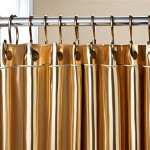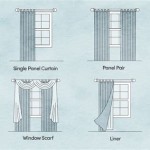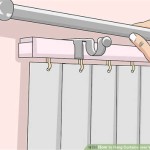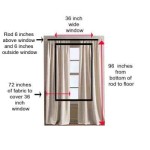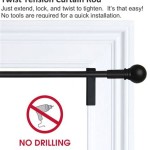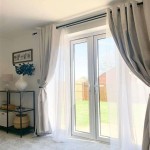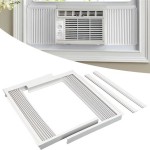Curtain Rods for Slanted Ceilings: A Comprehensive Guide
Slanted ceilings, also known as cathedral or vaulted ceilings, present unique design challenges when it comes to window treatments. Standard curtain rods, designed for level surfaces, are often incompatible, leading to installation difficulties and aesthetic compromises. Selecting the appropriate curtain rod for a slanted ceiling requires careful consideration of factors such as rod type, mounting hardware, fabric weight, and overall design integration. This article provides a comprehensive guide to navigating the complexities of choosing and installing curtain rods for slanted ceilings, ensuring both functionality and visual appeal.
Understanding the Challenges of Slanted Ceiling Installations
The primary challenge arises from the angle of the ceiling. Standard curtain rods, designed to hang horizontally, require level mounting surfaces. On a slanted ceiling, installing a standard rod can result in uneven curtain lengths, awkward angles, and potential instability. The angle of the slant also affects the amount of light that can enter the room and the overall thermal efficiency of the window treatment. The selection process must account for these factors to achieve the desired aesthetic and functional outcome.
Furthermore, the structural integrity of the slanted ceiling must be taken into account. Older homes, in particular, may have weaker support beams or plaster that is prone to cracking. Choosing the right mounting hardware and installation techniques is critical to avoid damaging the ceiling and ensuring the curtain rod remains securely in place. Understanding the composition and condition of the ceiling material is a prerequisite for a successful installation.
The desired drape of the curtains also contributes to the complexity. Curtains hung from a slanted ceiling may not fall uniformly, depending on the fabric weight and the rod's placement. This can create a visual imbalance and detract from the overall aesthetic appeal. Careful planning and consideration of the curtain's material and weight are necessary to achieve a balanced and visually pleasing drape.
Types of Curtain Rods Suitable for Slanted Ceilings
Several types of curtain rods are specifically suited for slanted ceiling installations. These rods are designed to accommodate the angle of the ceiling and provide a secure and aesthetically pleasing solution. The choice of rod depends on the specific design requirements and the weight of the chosen curtain fabric.
Track Systems: Track systems are a versatile option for slanted ceilings. These systems consist of a track mounted to the ceiling from which curtains hang via hooks or gliders. The track can be curved or straight, allowing for customized installations that follow the angle of the ceiling. Track systems are particularly well-suited for heavier curtains, as the weight is distributed evenly along the track. Furthermore, track systems can be easily motorized, providing automated control of the curtains.
Pivot Rods: Pivot rods feature adjustable brackets that allow the rod to be angled parallel to the floor, even when mounted to a slanted ceiling. These rods are ideal for lighter-weight curtains and sheer fabrics. The adjustable brackets provide flexibility in positioning the rod and ensuring a level hanging surface for the curtains. Pivot rods often offer a clean and minimalist aesthetic, blending seamlessly with various interior design styles.
Custom-Made Rods: For unique or complex slanted ceiling configurations, custom-made curtain rods offer a tailored solution. These rods are fabricated to specific dimensions and angles, ensuring a perfect fit for the space. While custom-made rods are generally more expensive, they provide the highest level of precision and design flexibility. They also allow for the incorporation of specialized features, such as integrated lighting or motorized operation.
Cafe Rods: Cafe rods, typically mounted with brackets that allow them to swing or tilt, can be adapted for slanted ceilings with the use of appropriately angled hardware. While usually used for lightweight curtains and providing privacy while still allowing light through, they can offer an interesting alternative for certain design styles. Ensuring the hardware can handle the weight of the chosen curtain is crucial for safety and functionality.
Combination Approaches: Often, a combination of different rod types and hardware is the most effective solution. For example, a track system might be used for the majority of the window's length, with a pivot rod used at the angled section to ensure a clean and level drape. This modular approach allows for customized solutions that address the specific challenges of the slanted ceiling.
Installation Techniques and Hardware Considerations
Proper installation is paramount for ensuring the safety and functionality of curtain rods mounted on slanted ceilings. The choice of hardware and the installation technique must be carefully considered to accommodate the angle of the ceiling and the weight of the curtains. Employing professional installation services is highly recommended, especially for complex installations or when dealing with fragile ceiling materials.
Bracket Selection: The brackets used to mount the curtain rod are critical for stability. Angled brackets, specifically designed for slanted ceilings, provide a secure and level mounting surface. These brackets are available in various sizes and materials to accommodate different rod types and curtain weights. The brackets should be securely attached to the ceiling joists or studs for maximum support. Using a stud finder is essential to locate the structural members behind the ceiling surface.
Anchor Systems: When mounting to drywall or plaster, appropriate anchor systems are necessary. Toggle bolts or molly bolts provide a secure hold in these materials. The type of anchor should be selected based on the weight of the curtains and the thickness of the ceiling material. Over-tightening the anchors can damage the ceiling, so care must be taken during installation. Consulting with a hardware specialist can help determine the most suitable anchor system for the specific application.
Leveling and Alignment: Ensuring the curtain rod is level is crucial for achieving a balanced and visually appealing drape. A spirit level or laser level can be used to accurately align the rod before securing the brackets. Any discrepancies in the ceiling angle should be compensated for by adjusting the bracket placement or using shims. Precise leveling ensures that the curtains hang evenly and do not appear lopsided.
Safety Precautions: Safety should always be a top priority during installation. Wearing safety glasses and gloves is recommended to protect against debris and potential injuries. When working at heights, a stable ladder or scaffolding should be used. It is also advisable to have a second person assist with the installation, especially when handling heavy curtain rods or fabrics. Disconnecting power to any nearby electrical fixtures is a prudent safety measure.
Fabric Weight and Drape: The weight of the curtain fabric significantly impacts the stability and appearance of the installation. Heavier fabrics require stronger rods and more robust mounting hardware. The drape of the curtains can also be influenced by the angle of the ceiling. Lighter fabrics tend to drape more naturally, while heavier fabrics may require additional support or adjustments to achieve the desired effect. The choice of fabric should be carefully considered in conjunction with the rod type and installation technique.
Considering the Ceiling Material: The composition of the ceiling material dictates the appropriate hardware and installation methods. Drywall and plaster require different types of anchors than wood or concrete. Older homes may have weaker plaster or deteriorated wood, requiring extra care during installation. Inspecting the ceiling material prior to installation can help identify potential issues and ensure the use of appropriate techniques.
Professional Consultation: For complex installations or when dealing with uncertain ceiling conditions, consulting with a professional installer is highly recommended. A professional can assess the specific challenges of the space and recommend the most suitable rod type, hardware, and installation technique. Professional installation can also provide peace of mind, ensuring the project is completed safely and correctly.
By carefully considering these factors and employing appropriate techniques, it is possible to successfully install curtain rods on slanted ceilings, enhancing the beauty and functionality of the space.

Sloped Angled Ceiling Shower Rod

Shower Rods Sloped Ceiling

Partial Sloped Ceiling Shower Rod Flat Black

Eaves Shower Rail Kit

Partial Sloped Ceiling Shower Rod

39 X Sloped Angled Ceiling Shower Rod

Sloped Ceiling Curtain Rod Mount Etsy Canada

How To Make A Angle Shower Rod For Angled Attic Walls Renovating Abandoned 3 Family Part 15

How Can I Hang A Shower Curtain In Bathroom With Slanted Ceiling Hometalk

Eaves Shower Rail Kit

